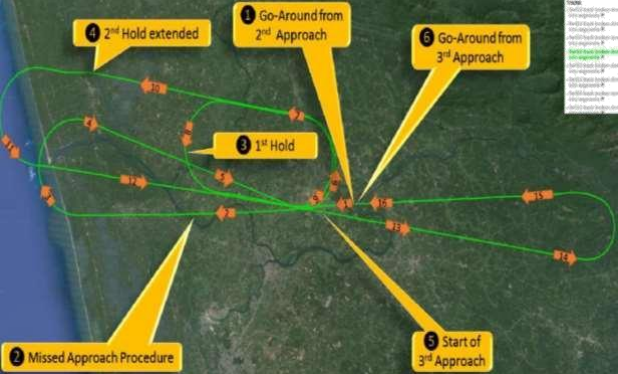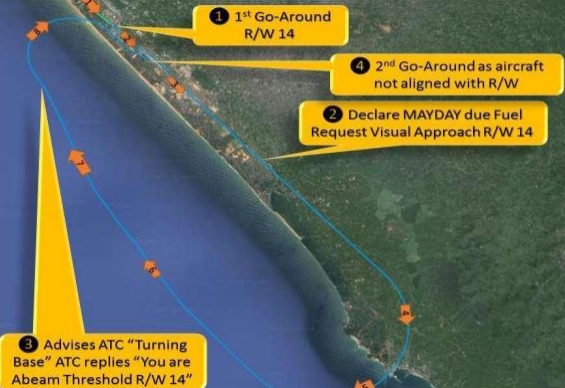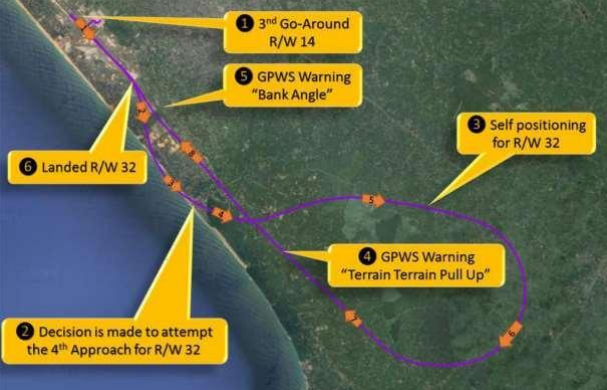A Jet Airways plane performed six go-arounds before landing on the seventh approach with insufficient fuel.
Jet Airways flight 9W555 took off around midnight from Doha, Qatar, bound for Cochin, India. The crew had to make three go-arounds in Cochin because of bad weather.
The pilots were allowed to land at runway 27 with an ILS approach, which allowed them to descend until it was 200 feet over the ground, something very useful in situations like this. The initial visibility was 3500m, and there were some clouds at 1500 feet, but when the pilots approached, they discovered that the weather was a lot worse. The crew could not see the runway or lights. They did a go-around. The first go-around was this one.
The situation wasn't intense because the plane was left with 4,699 kg of fuel.
They had two options: Divert to a different airport or attempt to land here at Cochin again.
The weather was good in Bangalore, which was 200 nautical miles away from their location. The airport in Trivandrum was 100 nautical miles away. Only a VOR approach could be made at the airport. The visibility at Trivandrum was just over 3000m.
The crew decided to begin the second ILS approach at Cochin, which didn't go as planned, and the aircraft performed go around for a second time. Flight 555 was told that other aircraft had trouble landing at Cochin. The captain decided to perform a third approach in Cochin instead of flying to Bangalore. The weather was getting worse. The crew performed an unsuccessful third approach after the ATC warned them about clouds.

The Boeing 737 had 4,844kg of fuel when it entered Cochin Airspace, and it went down to 4,699 kg on the first go-around, 3,919 kg on the second and 2,644 kg on the third attempt.
After three unsuccessful attempts in Cochin, they only had a small amount of fuel. The crew went to Trivandrum. The weather in Trivandrum was not great. The ATC at Cochin never forwarded this message to flight555. They were told that visibility was 1500m when they contacted Trivandrum.
The landing became more difficult as the ILS approach was unavailable. The crew did their fourth go-around. The fuel reserve is equivalent to 30 minutes of flight that can take the aircraft to the nearest airport. If the number drops below this, they have to declare May Day and land as soon as possible.

The crew requested a visual approach to runway 14 after declaring May Day. The Boeing plane lined up with only navigation displays. The approach was also unsuccessful and the crew went around for the fifth time. The approach was not successful and the aircraft went around for the sixth time.
Only 662 kilo of fuel was left after the sixth go-around. The pilot decided to go to the other side of runway 32.
The aircraft was flying just 700 feet above the ground, so low that the ground proximity warning system started to ring, which warned repeatedly, ‘Terrain, terrain pull up'.
The crew was incredibly low on fuel, so they couldn't follow the warnings. The captain made a blind landing as bad weather prevented them from seeing the runway and risked the lives of those on board. It could have been disastrous. The aircraft did not sustain any damage.

During the seventh approach, the first officer was heard asking, "Do you know where it is?"
The captain replied that he was just going blindly.
They were left with only 349 kg of fuel when it eventually landed. Had the pilots gone for another go-around, they would have crashed due to insufficient fuel, officials said.
The aircraft accident investigation bureau classified this as a serious incident after the critical incident. The plane was in a good state, and its condition was not a reason for the incident. The initial fuel planning was on point. Fuel policy, weather, expected delays, and adequate planning were done.
The weather was the most important factor in this incident. They were unable to land in Cochin due to poor weather and low-hanging clouds. The weather was getting worse. The visibility was 3000m in the initial approach, but dropped to 2500 by the time they reached Trivandrum. The crew made a decision that could have resulted in this. The idea of Bangalore attempting a landing at Cochin one more time was dropped by the pilot in command, as well as the selection of Trivandrum as an alternate airport where the VOR approach should be made. The findings show that if the crew had made better decisions early on, this incident wouldn't have happened.
The tape from Cochin ATC that was not recorded could not be used in the investigation. The ATC in Trivandrum inquired if the new weather conditions were told to the diverted flight. There is no record of Cochin ATCrelaying information. The weather was getting worse, which Cochin ATC should have reported. The pilot in command was faulted for the fact that the first officer had told about the VOR approach in Trivandrum, but the PIC ignored it. There was no company policy for multiple go-arounds. If a company policy existed, the decision not to divert to Bangalore could have been stopped. The crew ignored several warnings which put the safety of passengers and aircraft at risk.
The main reason for the incident was the lack of company policy for missed approaches in bad weather. The safety of passengers and aircraft was at stake as the aircraft had to ignore warnings. According to the final report, the lack of policies that assisted them with designating new destinations could have been the reason. New guidelines were added to Jet airways after the incident. New decision-making skills were taught. The pilots were not allowed to fly.
The flight was operated following standard operating safety procedures after it was diverted due to low visibility in Cochin.
Aviation_Accidents_Report_649Download“This is as per standard operating safety procedure. The flight landing with 141 guests was uneventful. At Jet Airways, safety is of paramount importance, and to this end, planning of flight operations are conducted with a very high level of safety. This includes a fuel uplift that not only meets all regulatory requirements, it has additional buffers to cater to unexpected scenarios including poor weather at the alternate airport."
Jet Airways Statement
Did you know about this incident? Do you know of any similar events? Tell us in the comments.
Wikimedia Commons has a featured image.